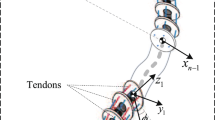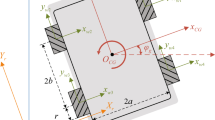Abstract
Impedance and Admittance Control are two well-known controllers to accomplish the same goal: the regulation of the mechanical impedance of manipulators interacting dynamically with the environment. However, they both are affected by a strong limitation deriving from their fixed causality, which causes their inability to provide good performance over a large spectrum of environment stiffnesses. In this paper an adaptive hybrid system framework is proposed to unify Impedance and Admittance formulations and consequently overcome this limit. Indeed, the hybrid framework interpolates the opposite performance and stability characteristics of the above-mentioned impedance-based control strategies leading to a family of controllers with intermediate properties, and thus suitable for several conditions. Moreover, the adaptivity allows the hybrid system to operate properly in an environment characterized by unknown and even time-varying stiffness. Especially, the work focuses on the development of this latter aspect and an adaptive solution based on a feedforward Neural Network is presented. The effectiveness of the novel control strategy is demonstrated by means of numerical simulations.
Similar content being viewed by others
References
Anderson, R.J., Spong, M.: Hybrid impedance control of robotic manipulators. IEEE J. Robot. Autom. 4(5), 549–556 (1988)
Cybenko, G.: Approximation by superpositions of a sigmoidal function. Math. Control Signals Syst. 2, 303–314 (1989)
Diolaiti, N., Melchiorri, C., Stramigioli, S.: Contact impedance estimation for robotic system. IEEE Trans. Robot. 21(5), 925–935 (2005)
Eppinger, S.D., Seering, W.P.: Understanding bandwidth limitations in robot force control. In: IEEE International Conference of Robotics and Automation, pp. 904–909 (1987)
Haykin, S.: Neural Networks and Learning Machines. Pearson, Prentice Hall (2009)
Hogan, N.: Impedance control: an approach to manipulation. ASME J. Dyn. Syst. Meas. Control. 107, 1–7 (1985)
Hogan, N.: Impedance control: an approach to manipulation. ASME J. Dyn. Syst. Meas. Control. 107, 8–16 (1985)
Hogan, N.: Impedance control: an approach to manipulation. ASME J. Dyn. Syst. Meas. Control. 107, 17–24 (1985)
Hornik, K., Stinchcombe, M., White, H.: Multilayer feedforward networks are universal approximators. Neural Netw. 2, 359–366 (1989)
Lawrence, D.A.: Impedance control stability properties in common implementations. In: IEEE International Conference of Robotics and Automation, pp. 1185–1190 (1988)
Liu, G.J., Goldenberg, A.A.: Robust hybrid impedance control of robot manipulators. In: IEEE International Conference of Robotics and Automation, pp. 287–292 (1991)
Love, L.J., Book, W.J.: Environment estimation for enhanced impedance control. In: IEEE International Conference of Robotics and Automation (1995)
Lu, W.S., Meng, Q.H.: Impedance control with adaptation for robotic manipulations. IEEE Trans. Robot. Autom. 7(3), 408–415 (1991)
Mason, M.T.: Compliance and force control for computer controlled manipulators. IEEE Trans. Syst. Man Cybern. SMC 11(6), 418–432 (1981)
Ott, C., Mukherjee, R., Nakamura, Y.: Unified impedance and admittance control. In: IEEE International Conference on Robotics and Automation, pp. 554–561 (2010)
Ott, C., Mukherjee, R., Nakamura, Y.: A hybrid system framework for unified impedance and admittance control. J. Intell. Robot. Syst. 78(3–4), 359–375 (2015)
Robert, M.H., Craig, J.J.: Hybrid position/force control of manipulators. ASME J. Dyn. Syst. Meas. Control. 105, 126–133 (1981)
Roveda, L., Iannacci, N., Vicentini, F., Pedrocchi, N., Braghin, F., Tosatti, L.M.: Optimal impedance force-tracking control design with impact formulation for interaction tasks. IEEE Robotics and Automation Letters 1(1), 130–136 (2016)
Roveda, L., Pedrocchi, N., Tosatti, L.M.: Exploiting impedance shaping approaches to overcome force overshoots in delicate interaction tasks. Int. J. Adv. Robot. Syst. 13(5), 1–11 (2016)
Roveda, L., Vicentini, F., Molinari Tosatti, L.: Deformation-tracking impedance control in interaction with uncertain environments. In: IEEE RSJ International Conference on Intelligent Robots and Systems (2013)
Seraji, H.: Adaptive admittance control: an approach to explicit force control in compliant motion. In: IEEE International Conference on Robotics and Automation, pp. 2705–2712 (1994)
Siciliano, B., Sciavicco, L., Villani, L., Giuseppe, O.: Robotics. Modeling, Planning and Control. Springer (2010)
Singh, S.K., Popa, D.O.: An analysis of some fundamental problems in adaptive control of force and impedance behavior: theory and experiments. IEEE Trans. Robot. Autom. 11(6), 912–921 (1995)
Slotine, J.J.E., Li, W.: Adaptive manipulator control: a case study. IEEE Trans. Autom. Control 33(11), 995–1003 (1988)
Yalcin, B., Ohnishi, K.: Environmental impedance estimation and imitation in Haptics by sliding mode neural networks. In: IEEE Industrial Electronics, pp. 4014–4019 (2006)
Acknowledgements
The first two authors would like to thank professor Ranjan Mukherjee, from Michigan State University, for having hosted them during the research, and dr. Christian Ott, from DLR, for the useful discussions about the topic presented in the paper.
Author information
Authors and Affiliations
Corresponding author
Rights and permissions
About this article
Cite this article
Cavenago, F., Voli, L. & Massari, M. Adaptive Hybrid System Framework for Unified Impedance and Admittance Control. J Intell Robot Syst 91, 569–581 (2018). https://doi.org/10.1007/s10846-017-0732-1
Received:
Accepted:
Published:
Issue Date:
DOI: https://doi.org/10.1007/s10846-017-0732-1




